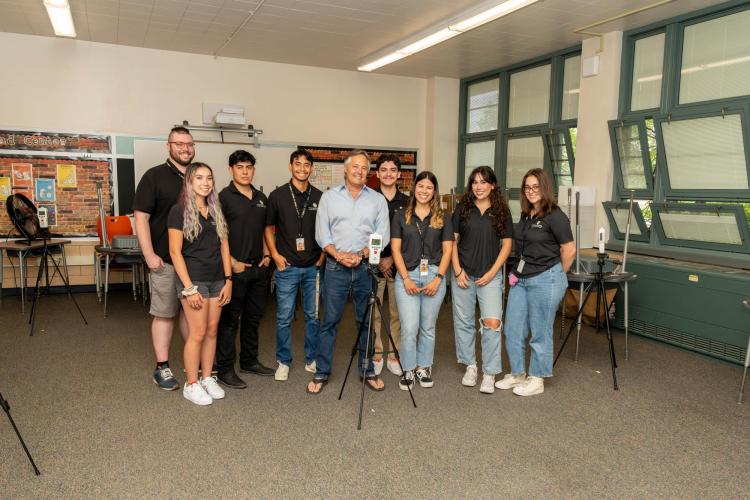Engineers at CU Boulder kicked off a new project this month that aims to investigate whether improving classroom air quality with air purifiers can help students miss fewer school days. The study comes at a time when millions of students across the country are chronically absent from school, a worsening trend that could have large impacts on students’ academic performance.
Mark Hernandez, the SJ Archuleta Professor in the Department of Civil, Environmental and Architectural Engineering, is co-leading the project with researchers at the CU Anschutz Medical Campus with a $2.2 million grant the Centers for Disease Control and Prevention awarded this month.
Over the past four months, Hernandez and his team, including eight engineering students, helped install air quality monitors in 2,400 classrooms across Colorado’s K-12 schools. These monitors can provide teachers, school officials and researchers with real-time data on classroom temperature, humidity, CO2 and air pollutant levels.
The team also helped install air cleaners with high-efficiency particulate air (HEPA) filters in tens of thousands of classrooms statewide. These commonly available air purifiers can effectively filter out air pollutants—such as particulate matter from vehicle exhaust and wildfire smoke—that can trigger negative respiratory reactions and remove airborne pathogens like the coronavirus. The team will compare student absenteeism rates in classrooms with air purifiers with those without.
“Linking positive student outcomes to affordable air quality interventions has yet to be done on a large epidemiological scale,” said Hernandez. “I am thankful our flagship engineering college and public health school was chosen by CDC to team up for this work as a national model.”
An epidemic of absenteeism
During the 2022–23 school year, over a third of Colorado K-12 students were chronically absent—defined as missing 10% of the school days in a year. That’s up from one in five students before the pandemic. Students are absent from school for a myriad of reasons—bullying, transportation problems and financial hardship—and asthma stands out as the leading cause of absenteeism due to chronic illness.
Funded by Colorado’s Ryan Innovation Fund, Hernandez started testing air purifiers in Denver Public School (DPS) classrooms in 2020, in an effort to help reopen schools under better conditions during the pandemic.
“When the pandemic broke out, there were a lot of people introducing air purifiers in classrooms. But many of the purifiers weren't sized correctly, didn’t work well or were too loud. No one had systematically assessed the purifiers’ performance in actual educational settings at this scale” Hernandez said.
In 2021, Hernandez and his team installed air purifiers coupled with air quality monitors in 20 public elementary school buildings with funding from the Intel Corporation and the Carrier Company. Most of the schools are located along the I-25 and I-70 highways, and their proximity to high-traffic corridors and industrial zones increases students’ exposure to air pollution, which could worsen the effects of COVID-19. In some of these schools, more than 20% of the students have asthma.
The pilot trial’s data showed that the purifiers, when working properly, were effective in improving classroom ventilation and reducing air pollutants. Impressed by the results, DPS funded Hernandez’s team to extend the program to 800 classrooms in 100 schools in 2021.
In 2022, Hernandez received a $5.5 million grant from the Colorado Department of Public Health and Environment to expand the work state-wide into a new program called Clean Air for Schools. The additional CDC grant will allow the team to continue monitoring air quality in Colorado classrooms and investigate if there is a connection between air purifier operations, ventilation performance and student attendance.
“Until COVID-19, nobody really did anything about air quality in classrooms except in response to extreme weather conditions. Many political leaders and agency decision-makers projected systemic air quality improvements to be too expensive,” Hernandez said.
An inexpensive, but powerful solution
Hernandez estimates that effectively reducing airborne particles in indoor air pollution with air purifiers would cost $65 per student, per classroom, per year.
“Installing a couple of air purifiers in a classroom is cheaper than a textbook, but schools are always strapped for money. Now we have data that shows these commonly available appliances, which don’t disrupt teaching, can be systematically prioritized. It’s well worth it in both the immediate and long term,” Hernandez said.

CU Boulder students set up air monitors in a classroom. (Credit: Jesse Morgan Peterson)
The project has a huge community and educational impact, Hernandez added. He is proud of the students and contractors who worked day and night to install the air monitors in thousands of classrooms over the past summer. Many of the young researchers working on the project are first-generation college students who come from communities disproportionately affected by air pollution and COVID-19. Studies have found that Black and Hispanic students have the highest asthma rates in the U.S.
“A few of my students actually attended these schools near the industrial zones, and they are able to give back to the community with their education,” Hernandez said. The diverse group of students will continue to track the data and analyze air quality’s impact on absenteeism using the new grant.
“While I’m an engineer, I’m also an educator. Through this project, I get to work with our engineering students and watch them increase their skills and competence and advance their educational potential while doing something good for the community. This is one of the most rewarding projects I've had in nearly 30 years here at CU,” Hernandez said.





